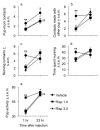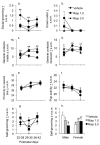Early-life risperidone administration alters maternal-offspring interactions and juvenile play fighting
- PMID: 25600754
- PMCID: PMC4357390
- DOI: 10.1016/j.pbb.2015.01.007
Early-life risperidone administration alters maternal-offspring interactions and juvenile play fighting
Abstract
Risperidone is an antipsychotic drug that is approved for use in childhood psychiatric disorders such as autism. One concern regarding the use of this drug in pediatric populations is that it may interfere with social interactions that serve to nurture brain development. This study used rats to assess the impact of risperidone administration on maternal-offspring interactions and juvenile play fighting between cage mates. Mixed-sex litters received daily subcutaneous injections of vehicle or 1.0 or 3.0mg/kg of risperidone between postnatal days (PNDs) 14-42. Rats were weaned and housed three per cage on PND 21. In observations made between PNDs 14-17, risperidone significantly suppressed several aspects of maternal-offspring interactions at 1-hour post-injection. At 23 h post-injection, pups administered risperidone had lower activity scores and made fewer non-nursing contacts with their moms. In observations of play-fighting behavior made once a week between PNDs 22-42, risperidone profoundly decreased many forms of social interaction at 1h post-injection. At 23h post-injection, rats administered risperidone made more non-social contacts with their cage mates, but engaged in less social grooming. Risperidone administration to rats at ages analogous to early childhood through adolescence in humans produces a pattern of abnormal social interactions across the day that could impact how such interactions influence brain development.
Keywords: Antipsychotic; Autism; Development; Dopamine; Forebrain; Social behavior.
Copyright © 2015 Elsevier Inc. All rights reserved.
Conflict of interest statement
All authors declare no conflict of interest.
Figures


References
-
- Bardgett ME. Behavioral models of atypical antipsychotic drug action. In: Csernansky J, Laurello J, editors. Atypical antipsychotics: From bench to bedside. New York: Marcel Dekker; 2004. pp. 61–93.
-
- Bardgett ME, Humphrey WM, Csernansky JG. The effects of excitotoxic hippocampal lesions in rats on risperidone- and olanzapine-induced locomotor suppression. Neuropsychopharmacology. 2002;27:930–38. - PubMed
-
- Beatty WW, Costello KB, Berry SL. Suppression of play fighting by amphetamine: Effects of catecholamine antagonists, agonists and synthesis inhibitors. Pharmacol Biochem Behav. 1984;20:747–55. - PubMed
Publication types
MeSH terms
Substances
Grants and funding
LinkOut - more resources
Full Text Sources
Other Literature Sources
Medical

